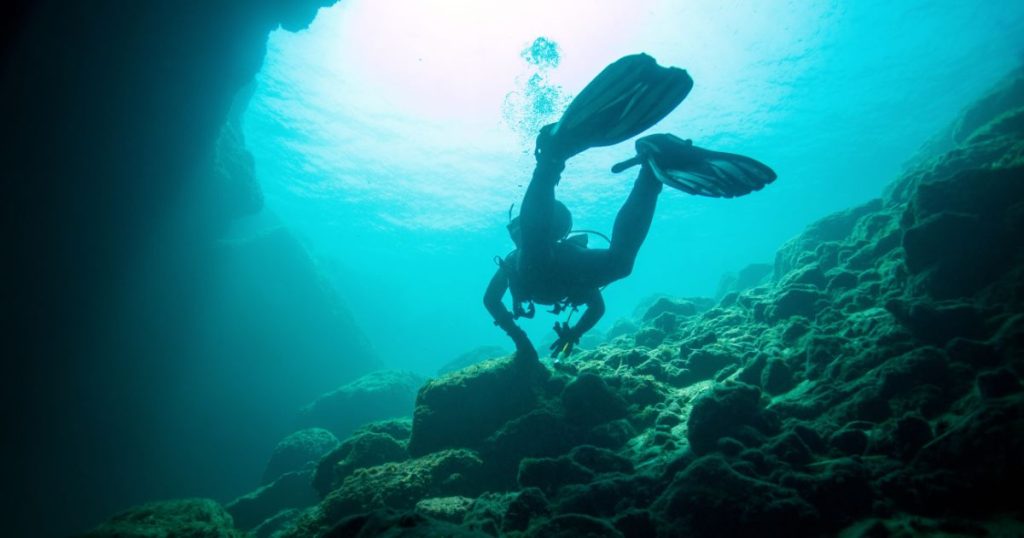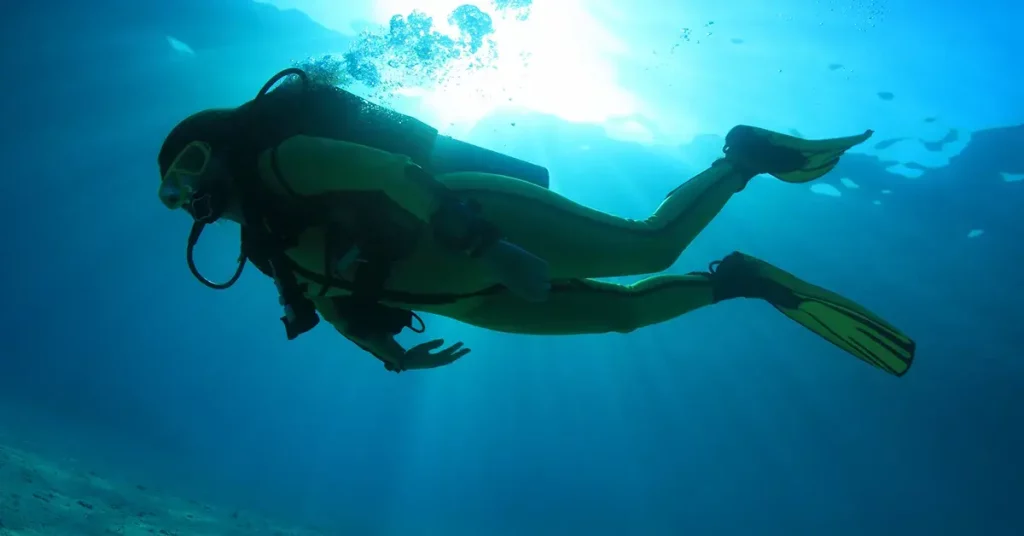Neoprene wetsuits are an amazing piece of technology. They give you the ability to stay submerged in cold water far longer than would be possible under normal conditions. One of the most commonly asked questions by divers, surfers, kayakers, and other watersports enthusiasts is “how do wetsuits work?”.
How are they able to provide insulation and warmth even though their porous design allows some water to come in direct contact with your skin?
Let’s take a closer look at how neoprene wetsuits work, break down the science behind their construction, and examine several different wetsuit designs and types.
How Do Wetsuits Keep You Warm?

Wetsuits work by utilizing different layers to trap and reflect heat back to your body. Much like layering with multiple materials during the wintertime, wetsuits make use of several types of insulation at the same time.
While it might seem counterintuitive, wetsuits keep you warm even when there’s a thin layer to water trapped between the wetsuit and your skin.
Wetsuits use multiple layers – including neoprene foam – to trap a thin layer of water between the wetsuit material and your body. This layer of water warms up from being in contact with your body heat – which turns it into another form of insulation.
If your wetsuit has a poor fit, is too loose, or has gaps in the collar or sleeves, then cold water will seep in and out, negating much of the insulating effect. This is why ensuring your wetsuit fits properly is so important.
Above the trapped water is typically a protective lining, often nylon, which works to protect your body from chafing against the neoprene foam.
Depending on the wetsuit design, the next layer may be a thin heat reflective metallic layer. This layer can be made from copper, aluminum, titanium, or magnesium. It works by reflecting your body’s own heat inwards – further preventing heat loss.
Next comes the main layer of neoprene foam. Neoprene is a synthetic rubber material made with tiny nitrogen bubbles trapped inside. These nitrogen bubbles provide excellent insulation and added buoyancy while remaining highly flexible.
Finally, the outer layer is made from an anti-abrasion material to protect the other layers from scrapes and scratches which are sometimes difficult to avoid around rocks, coral, and wrecks.
Open Cell vs. Closed Cell Wetsuits

Closed cell wetsuits
Closed cell wetsuits are the most common type used by divers. They use an inner protective layer designed to protect the neoprene from damage and to provide comfort to the user. (This is the type described above.)
Open cell wetsuits
Open cell wetsuits differ slightly from their closed cell counterparts. They’re made without an inner protective layer – so the neoprene foam rests directly against your skin. This offers several benefits, as well as several drawbacks.
| Open Cell | Closed Cell | |
| Mobility | ✓ | |
| Insulation | ✓ | |
| Durability | ✓ | |
| Price | $$$ | $ |
Open cells are much more flexible than closed cell wetsuits. This translates to more natural movement under the water and a more comfortable overall experience. They can be worn for longer periods than closed cells, which make them great for longer dives – or anytime you plan to wear a wetsuit all day long.
The open cell design also provides more warmth than a closed cell of the same thickness. Because the neoprene adheres directly to your skin, water can’t get inside the interior of the wetsuit. This also makes them more difficult to slide on, so you’ll need to use some kind of lubricant to help you don and doff them.
Freedivers and spearfishermen tend to favor open cells due to these benefits.
The downside to open cells is their durability and price. They’re more susceptible to scratches and abrasion than closed cells are, so you need to be more careful when wearing one. They also cost significantly more, which makes them a bit expensive for the casual user.
Wetsuit thickness largely determines its thermal effectiveness. Naturally, thicker wetsuits provide a higher level of insulation than thinner ones. The water temperature where you dive, surf, or swim will largely influence the best thickness for your needs.
Wetsuit Thickness

Thickness is measured in millimeters, with one, two, or sometimes three numbers used. One number – 2mm for example – indicates the same neoprene thickness is used throughout the entire wetsuit. Multiple numbers – such as 4/3 – indicate different neoprene thicknesses are used in different sections of the suit.
The thicker material is used around the torso, with the thinner material is used around the arms and legs. Some wetsuits use three numbers, indicating different thicknesses used in the torso, arms, and legs respectively.
Thicker neoprene around the torso helps to trap heat around your core, while thinner neoprene in the arms and legs increases flexibility and mobility in the water.
The ideal wetsuit thickness for your needs will vary slightly, depending on the air temperature, wind conditions, activity level, sensitivity to cold, and your body fat percentage.
With that in mind, some general water temperature guidelines for wetsuit thicknesses are as follows:
- 2mm: 62°- 68° F (17° – 20° C)
- 3mm: 58° – 63° F (14° – 17° C)
- 4mm: 52° – 58° F (11° – 14° C)
- 5mm: 43° – 52° F (6° – 11° C)
- 6mm+: 42° F and below (5° C and below)
In colder waters below 58° F, a good pair of dive boots or socks becomes a necessity, and below 42° F, you’ll want to don a hood and pair of insulated dive gloves.
Wetsuit Seams
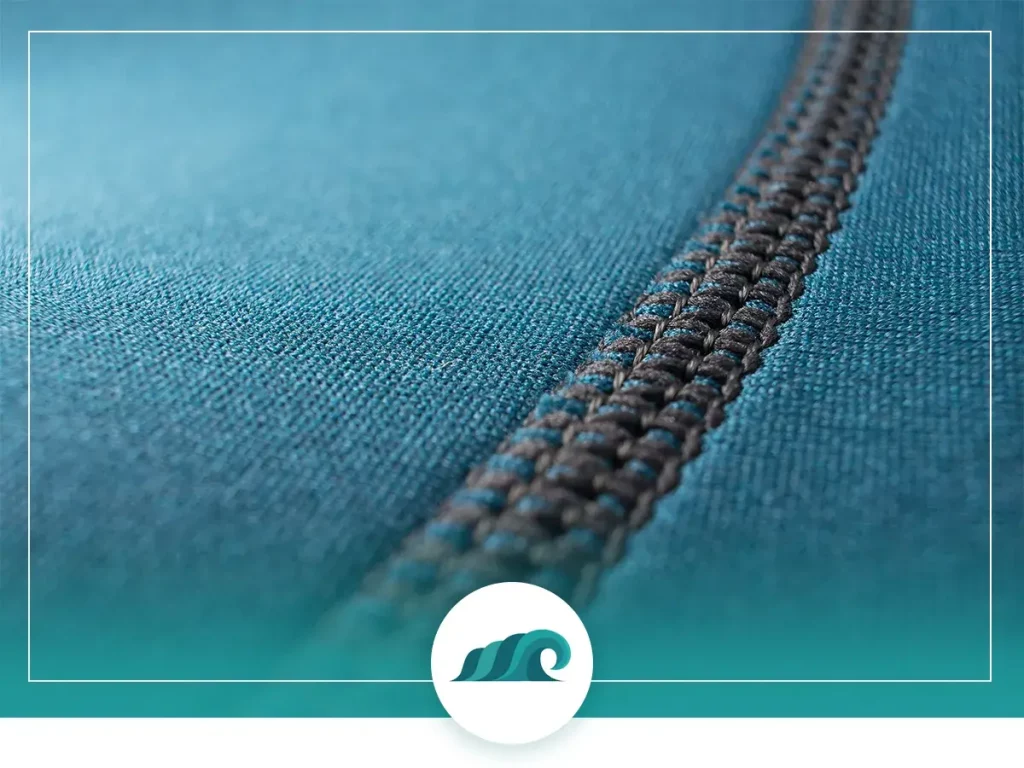
A wetsuit’s seams, stitching, and zippers have a major impact on the way it feels and performs in the cold. Various stitching methods are used to create different types of seams, each with its own level of waterproofing.
Flatlock Seams
Fetlock seams are often found in lower-priced wetsuits. They allow some water to flow inside the wetsuit, so are more suitable to warm water environments above 62° F. The criss-cross stitch pattern used in these seams is stitched all the way through the seam – which means a small amount of water can seep inside.
Glued and Blind Stitched Seams
Glued and blind stitched seams are common in wetsuits designed for cold weather usage. They’re formed by panels glued together and then blind stitched. The blind stitching doesn’t penetrate all the way through the neoprene, which prevents water from seeping through and greatly enhances warmth.
Interior Seam Taped Seams
Interior seam taped seams are similar to the glued and blind stitched type above, but with an added layer of interior taping. This taping further prevents water from getting into the interior of the suit, as well as increasing the level of comfort. This type of seam is typically used in wetsuits intended for water temperatures below 55° F.
Wetsuit Zippers

Zippers are another important feature that impacts the warmth and comfort of a wetsuit. There are three types of zipper closures typically used in wetsuits: full front zippers, chest zippers, and back zippers.
Full Front Zippers
Full front zippers are the most common type of wetsuit used for swimming and are easy to don and doff. They feature a full-length zipper that runs down the front from the neck to the waist. These zippers allow some water to get inside, so they are usually used in lighter weight wetsuits.
Chest Zippers
Chest zippers are a bit trickier to put on and take off than other types but provide excellent water resistance and comfort. The chest zipper allows for greater mobility than other types, as the back panel is made from one continuous neoprene panel, which makes it common in higher-end surfing wetsuits.
Back Zippers
Back zippers are the classic design with the zipper going down the length of the spine, and an attached lanyard for zipping yourself in and out. They’re fairly easy to get in and out of and do a decent job of keeping out water. Many manufacturers use some form of flush guard around the zipper to further prevent water from getting in. The back zipper can restrict your movement to some degree, which can impact your mobility in the water.
There are also some lighter wetsuits with zipperless closures. These offer excellent mobility overall but sacrifice some warmth in the process.
Do Wetsuits Make You Float?
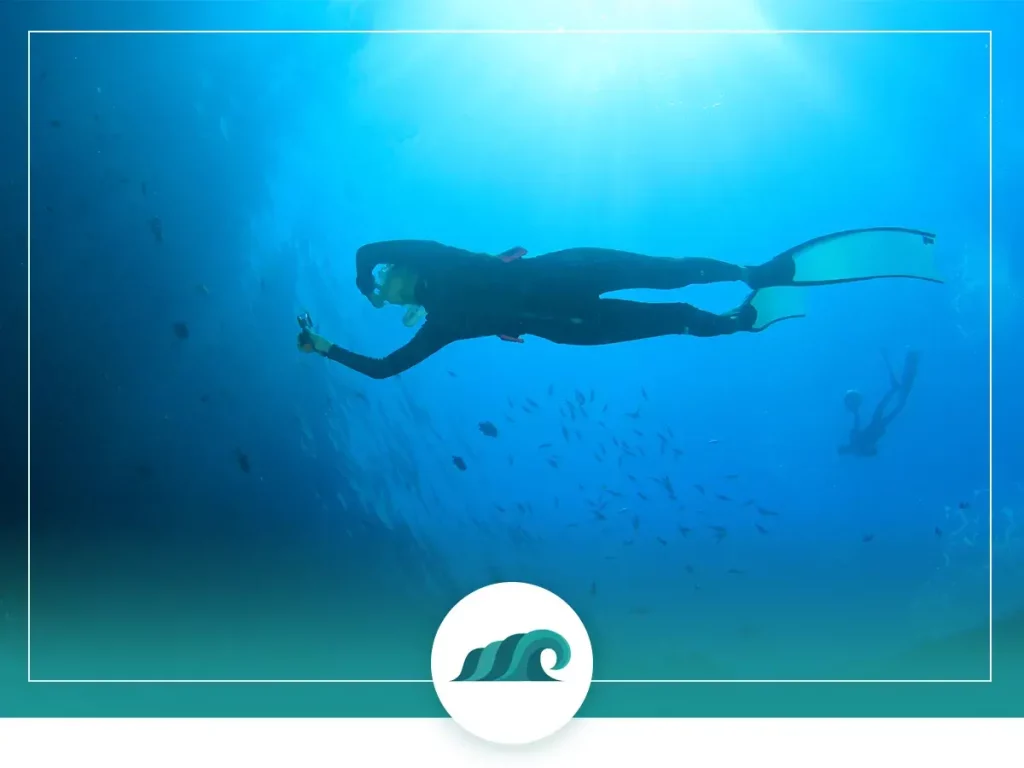
Neoprene provides some degree of buoyancy, with thicker wetsuits providing significantly more buoyancy than thinner ones. In colder environments, divers will need to add additional weight to their weight belts to compensate for the added buoyancy from a thicker wetsuit.
Depending on the type of wetsuit, added buoyancy may be built into the design. Wetsuits designed for triathlons and long-distance swimming will often feature extra buoyancy in strategic areas, giving the user extra lift in the water.
Do You Wear Anything Under a Wetsuit?
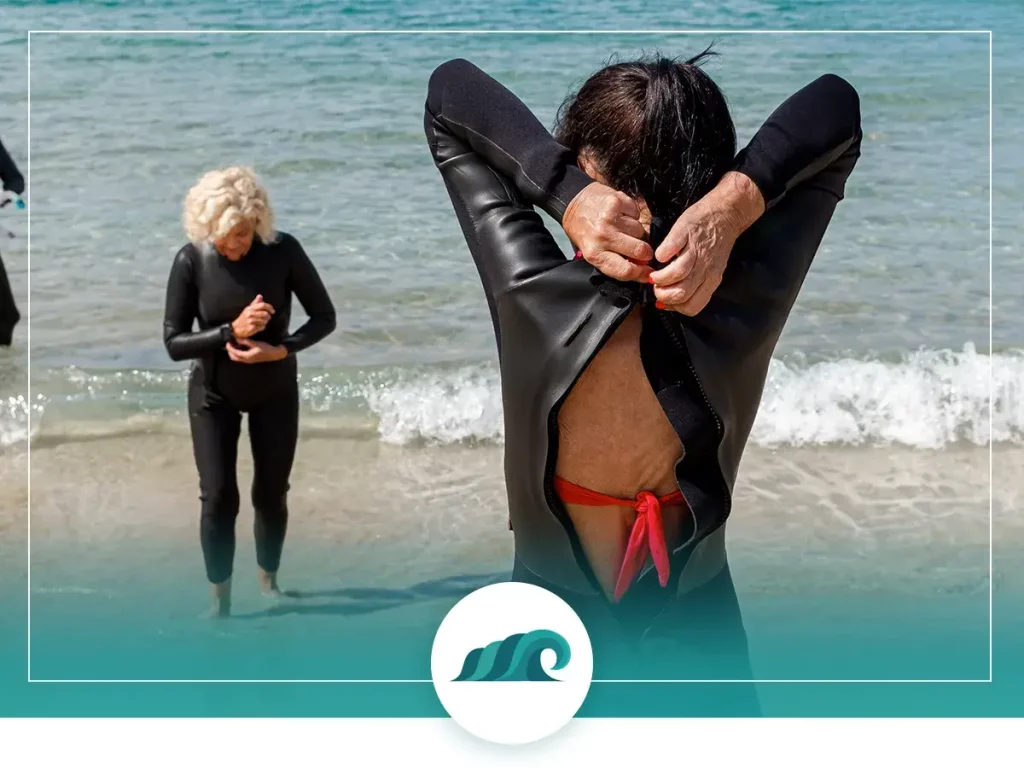
This one really comes down to personal preference. Many divers, surfers, and kayakers prefer to wear nothing but swim trunks or a bikini underneath, while others like to go completely commando!
The important thing to consider when picking something to wear underneath your wetsuit is how it will impact the wetsuit’s fit. If you’re going to wear swim trunks or board shorts, then make sure they’re fairly tight-fitting and won’t bunch up and cause discomfort. A pair of lycra or neoprene shorts also well work in this case.
Some people like to wear a light rash guard or rash vest under their wetsuit. These help to prevent chafing in sensitive areas. You can also find specialized anti-chafing gels and creams designed to protect your skin from damage.
If you’re diving in cold water, then you can add some thermal lycra layers underneath your wetsuit. This will provide some extra warmth, but can also take longer to warm up than without theses layers. If the water is very cold, then a dry suit or semi-dry suit may work better than a wetsuit.
Do Wetsuits Keep You Warm Out of the Water?

Like any other piece of clothing, wetsuits work to provide warmth and insulation when out of the water. The neoprene material protects the wearer from the wind and cold, due to the thin layer of water inside the neoprene which warms up and acts as insulation.
Even though they don’t typically submerge fully in the water, wetsuits are often worn by kayakers, stand up paddleboarders, and canoeists. This is due to the protection offered by neoprene.
Wrap Up
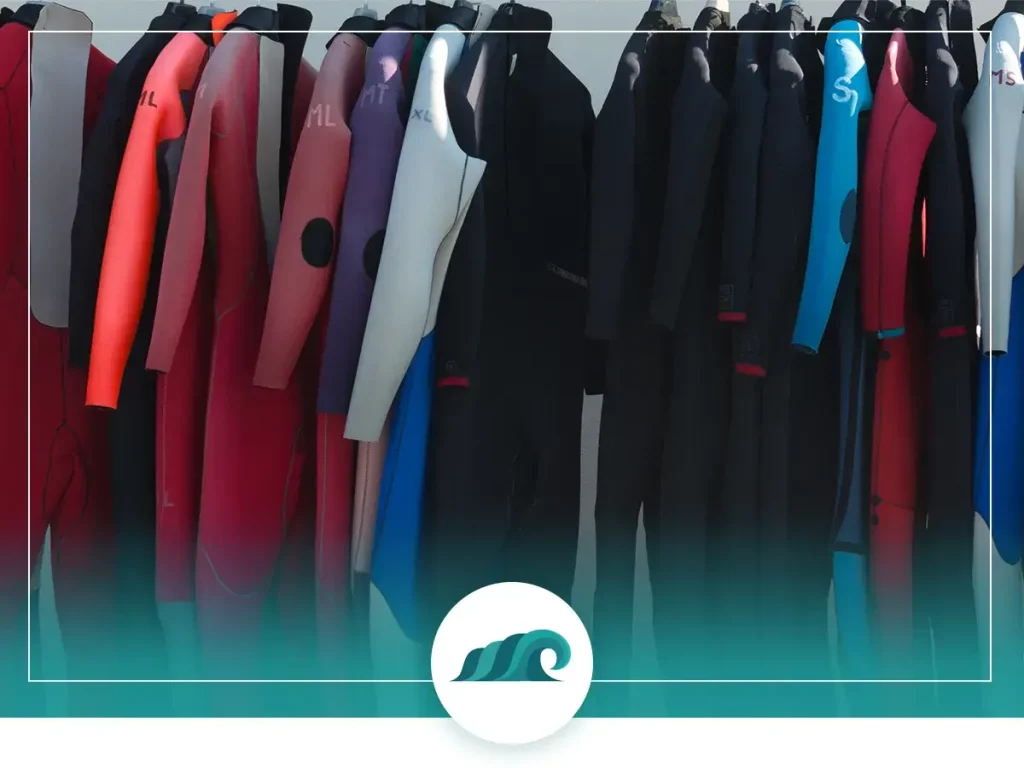
Hopefully, you now have a better understanding of how wetsuits work, and the next time someone asks you ‘how do wetsuits work?’, you’ll be well prepared to answer them.
The most important thing to keep in mind is that wetsuits keep you warm despite the thin layer of water trapped between your skin and the wetsuit material. Wetsuits where the neoprene rests directly against your skin prevent any water from seeping inside, which results in better thermal performance. These wetsuits are known as open cell wetsuits.
Closed cell wetsuits work by letting in a small amount of water, which needs to be kept inside the suit to prevent ‘flushing’, which is when cold water seeps in and replaces the trapped warm water.


